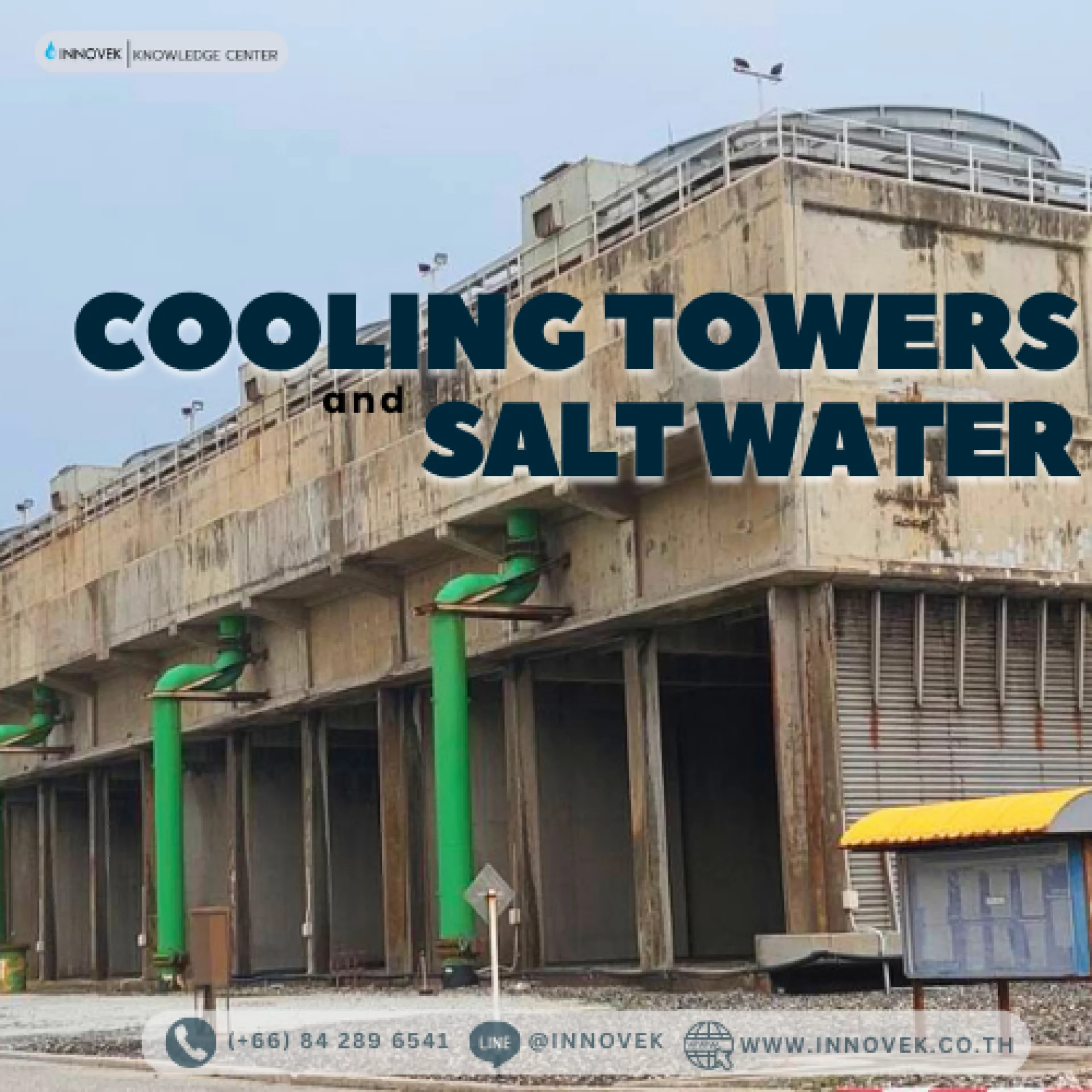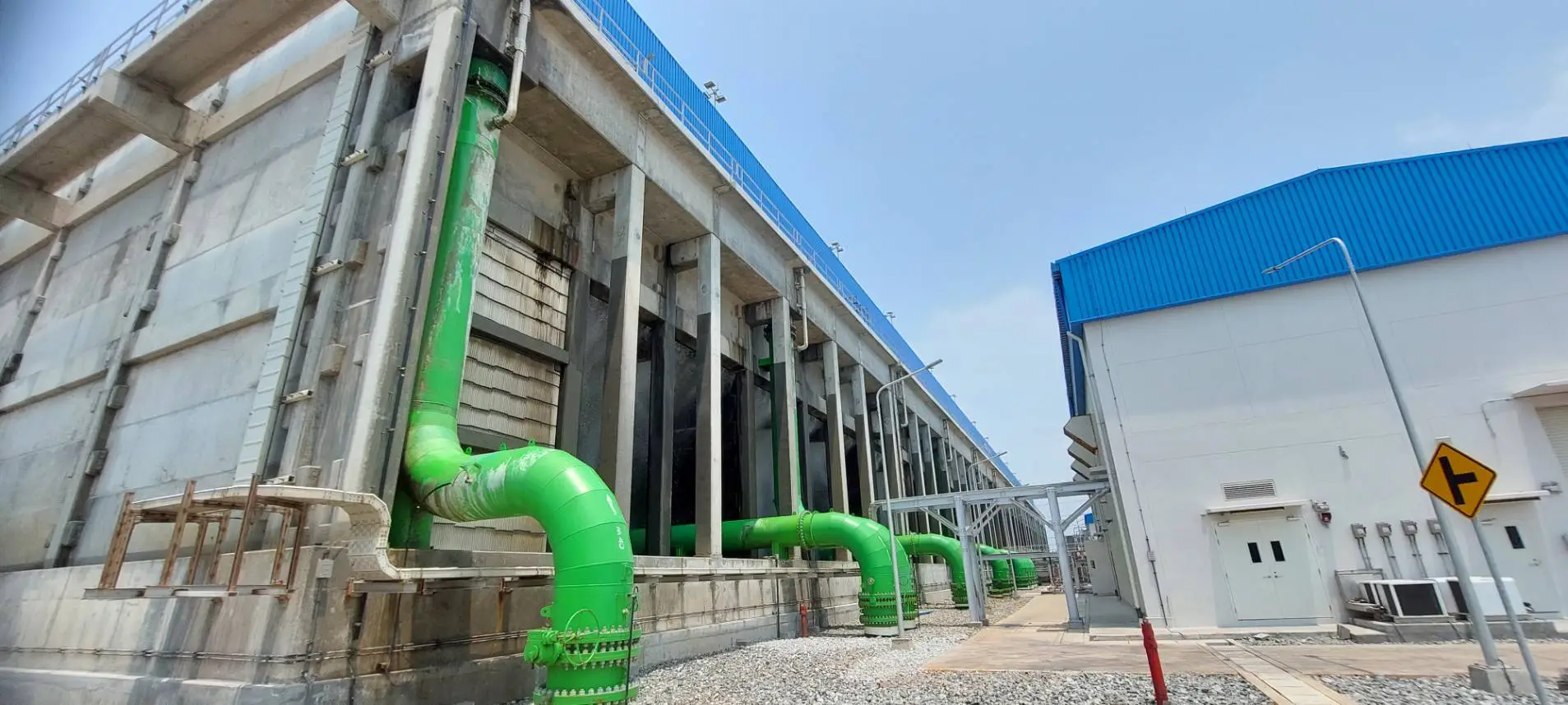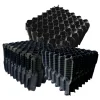Cooling Towers and Salt Water

What is the salt water?
For cooling tower systems, circulating water with chloride content above 750 parts per million (ppm), expressed as sodium chloride (NaCl), is generally considered as salt water. However, the effects of chlorides are much less severe at the 750 ppm level compared to higher concentrations.
Salt water may come from the open sea, brackish water (such as estuaries), or saltwater wells. Since open-recirculating cooling systems concentrate dissolved solids in the water, a cooling tower may still be considered as operating with salt water even if the makeup water contains less than 750 ppm NaCl.
If the makeup water comes from open seawater, its typical composition might be:
- 185 ppm - Calcium bicarbonate (Ca(HCO))
- 1,200 ppm - Calcium sulfate (CaSO)
- 2,150 ppm - Magnesium sulfate (MgSO)
- 3,250 ppm - Magnesium chloride (MgCl)
- 27,000 ppm - Sodium chloride (NaCl)
- 500 ppm - Potassium chloride (KCl)
- 100 ppm - Potassium bromide (KBr)
- Total salinity: 35,000 ppm
- Total alkalinity: 15 ppm (as CaCO)
- pH: approximately 8
How does salt water affect cooling towers?
Materials - The main effect of salt water is an increased corrosion rate on metallic components in the cooling tower and heat rejection system. It can also loosen wood fibers (in wooden structures) where components alternate between wet and dry conditions. These issues can be addressed by selecting appropriate materials and coatings, explained further in later sections.
Fouling - Fouling may be biological (slime, algae), inorganic (scale), or other contaminants (oil, debris, etc.). Suspended abrasive particles (such as sand) can also be problematic, increasing both corrosion and wear.
Thermal performance - Salt affects three water properties that influence cooling efficiency:
- Lowers vapor pressure
- Reduces specific heat
- Increases solution density
Points 1 and 2 reduce cooling efficiency, while point 3 offers a slight improvement. However, the density effect is too small to offset the losses from reduced specific heat and vapor pressure. Therefore, cooling efficiency decreases slightly.
Losses are greater at higher salinity and under heavy cooling loads. For example, at 55,000 ppm salinity, the efficiency loss for a typical mechanical draft cooling tower is about 24%, depending on load severity. These losses can be recovered by adjusting variables such as:
- Tower size
- Fan horsepower
- Water circulation rate
The R&D department of Innovek Asia has rating systems that can accurately calculate cooling tower performance reductions based on salinity and heat load, enabling precise tower sizing for saltwater applications.

Environmental impact of saltwater cooling towers
Two key concerns are drift and blowdown. Drift and blowdown water will have the same total dissolved solids (TDS) concentration as the circulating water. Modern technology can accurately measure drift volume and droplet size.
In most modern cooling towers, drift rates are about 0.005%0.02% of total circulation. With well-designed drift eliminators, rates below 0.005% are achievable. Even with low drift, saltwater towers should not be installed near corrosion-sensitive or delicate equipment (e.g., electronics) because even small amounts of saltwater mist can cause damage.
Blowdown from saltwater towers will have much higher TDS than makeup water. For seawater-fed systems, circulating water concentration is usually less than twice that of raw seawater.
Currently, no major problems are reported in disposing of blowdown from saltwater towers, provided no toxic chemicals are added. Still, blowdown is a regulated activity, and operators should check local authority requirements to ensure compliance.
Precautions for saltwater cooling tower construction
Structure - Common materials for freshwater towers include FRP, wood, steel, or concrete. Due to high corrosion risk, steel structures are not recommended for saltwater towers.
- Pultruded FRP Excellent corrosion resistance; best choice for saltwater cooling towers.
- Wood California redwood or Douglas fir, pressure-treated for decay resistance, performs well in saltwater. Durability is similar to freshwater, except in alternating wet/dry areas where high salt concentration may cause surface damage.
- Concrete Use dense Type II Portland cement, low water/cement ratio, air-entrained mix, with microsilica or metakaolin additives.
- Reinforcing steel should be epoxy-coated.
- Connectors should be corrosion-resistant (plastic or ceramic).
- Bolts: duplex stainless steel (e.g., 2205) or silicon bronze (avoid silicon bronze where sulfides or ammonia are present).
- Submerged areas: use duplex stainless, red brass, or silicon bronze.
Casing and louvers - Use FRP for excellent corrosion resistance. Seal all joints tightly to prevent salt accumulation.
Fill and drift eliminators - Wood or durable plastics are suitable.
Fan cylinders - FRP is preferred. Metallic parts should be stainless steel or silicon bronze.
Mechanical equipment -
- Fan blades - FRP, glass-reinforced vinyl ester, or corrosion-protected aluminum.
- Gearboxes, bearings, fan hubs - Cast iron with heavy epoxy enamel coating.
- Structural steel frames and welded hubs - Coat with epoxy enamel.
- Drive shafts - Stainless steel 316, fiberglass, or carbon fiber.
- Bolts/nuts - Stainless steel 316 for corrosion resistance and reduced galvanic reactions.
Distribution system
- Do not use uncoated steel piping.
- Use PVC or FRP.
- Steel or cast iron fittings should be epoxy enamel- or porcelain-coated.
- Bolts: stainless steel 316, duplex stainless, Monel, or silicon bronze (avoid in high-flow areas).
0Cold water basin
- Usually made from concrete, FRP, or wood.
- Steel is not recommended.
- FRP excellent corrosion resistance.
- Wood unaffected by saltwater.
- Concrete dense mix, Type II cement, low water/cement ratio, air-entrained.
Fouling control
- Use appropriate biocides for slime/algae control.
- Chlorination is effective for seawater systems due to bromine release during use.
- Maintain free chlorine at ~0.5 ppm.
- For marine animal contamination, raise to 3 ppm and dose continuously for up to 72 hours. - Alternate chlorine with non-oxidizing biocides for better microbial control.
- Scale is uncommon in saltwater towers but may clog heat exchangers if present.
- Seawater can be concentrated up to ~55,000 ppm without pH adjustment and without scaling issues.
- Beyond this, acid dosing may be needed for pH control.
- Some large users operate at these levels without problems.
Conclusion: Cooling towers with salt water a practical industrial solution
Even when only salt water is available as makeup water, cooling towers can operate efficiently and sustainably if appropriate materials and coatings are selected for corrosion resistance. Accurate thermal performance assessment is also essential to ensure design targets are met.
Managing cooling towers with salt water is complex and requires expertise. INNOVEK, as a cooling tower specialist with one stop service, offers free consultation for challenges involving saltwater cooling towers from material selection and design to system optimization.
Contact INNOVEK today for your free consultation!
ID LINE : @innovek
(+66) 84 289 6541 : 25 HOURS


